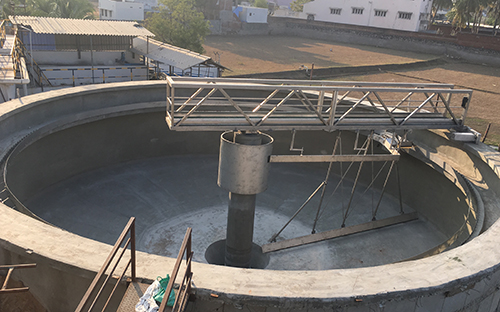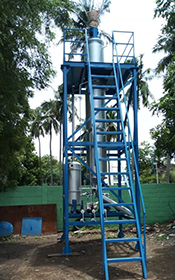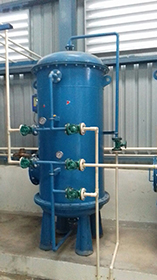Products
Clarifier
Sedimentation is the term applied to the separation of suspended particles that are heavier than water, by gravitational settling. In the case of the proposed biological wastewater treatment, it is used for the removal of the activated – sludge. A top scraper removes the floating material and foam, while the bottom scraper sends the settled sludge to the center of the tank where it is pumped back to the process. Most of the removed sludge is sent back to the process, in order to keep a constant concentration of activated sludge in the biological oxidation or aeration tank, so that the process efficiency is also constant. The excess sludge that is produced is sent for further processing and then removal.


Evaporator and Agitated Thin Film Dryer (ATFD)
The solution containing the desired product is fed into the evaporator and passes across a heat source. The applied heat converts the water in the solution into vapour. The vapour is removed and condensed while the now-concentrated solution is either fed into an ATFD. The ATFD is a double walled vessel with a heating medium such as steam. The process fluid flows through the vessel and the steam in the jacket of the vessel causes the liquid to evaporate and go back to the process while the solids are deposited on the vessel wall. The scraper removes the deposits from the wall and collects it at the bottom of the ATFD. Mechanical Evaporators and ATFDs are usually used in combination in Zero Liquid Discharge Effluent Treatment Plants.
Agitator
An agitator is a device that disrupts a collected fluid by stirring or shaking. As agitations is an integral process in most waste water, sewage and effluent treatment processes, there is a wide need for agitators. They are motor driven.
Reverse Osmosis
The reverse osmosis treatment generally is applied to removal of salts and such impurities from water that is destined for either human consumption or release into the environment. The aim of the treatment by RO is reduction of 95 - 98% of dissolved salts and removal of bacterial charge from clear (filtered) water. The process of reverse osmosis is based on the peculiarity of half-permeable membranes, which water (or other solvents) is passing through, while molecules are retained as well as the ions of the dissolved solids.


Softener
Water softening is the removal of calcium, magnesium, and certain other metal cations in hard water. The resulting soft water is more compatible with soap and extends the lifetime of plumbing. Water softening is usually achieved using ion-exchange resins. It can also be used to revive soapy water for re-use.
Filter
The filtration removes the suspended solids from the effluent. The filter material, packing size and porosity is determined based on the process conditions. The filter casing is manufactured for easy maintenance and usually incorporates a screen to hold the media in position. The differential pressure across filters is closely monitored to ensure maximum efficiency in operation of the plant.


Ultra-Filtration / Nano Filtration
Ultra-filtration is sub-process within water, sewage or effluent treatment plants. It is a time-based operation and after a specified number of filtration cycles, a chemical enhanced backwash occurs. As optimum operating mode of the plant has to be uniquely identified for each process based on the water quality is provided. During the operation, the water is pressed from the feed side through the membrane capillaries to the filtrate side. This ensures that the contaminant particles are filtered. Similarly, the treated water can be further purified by using finer nano-membranes.
